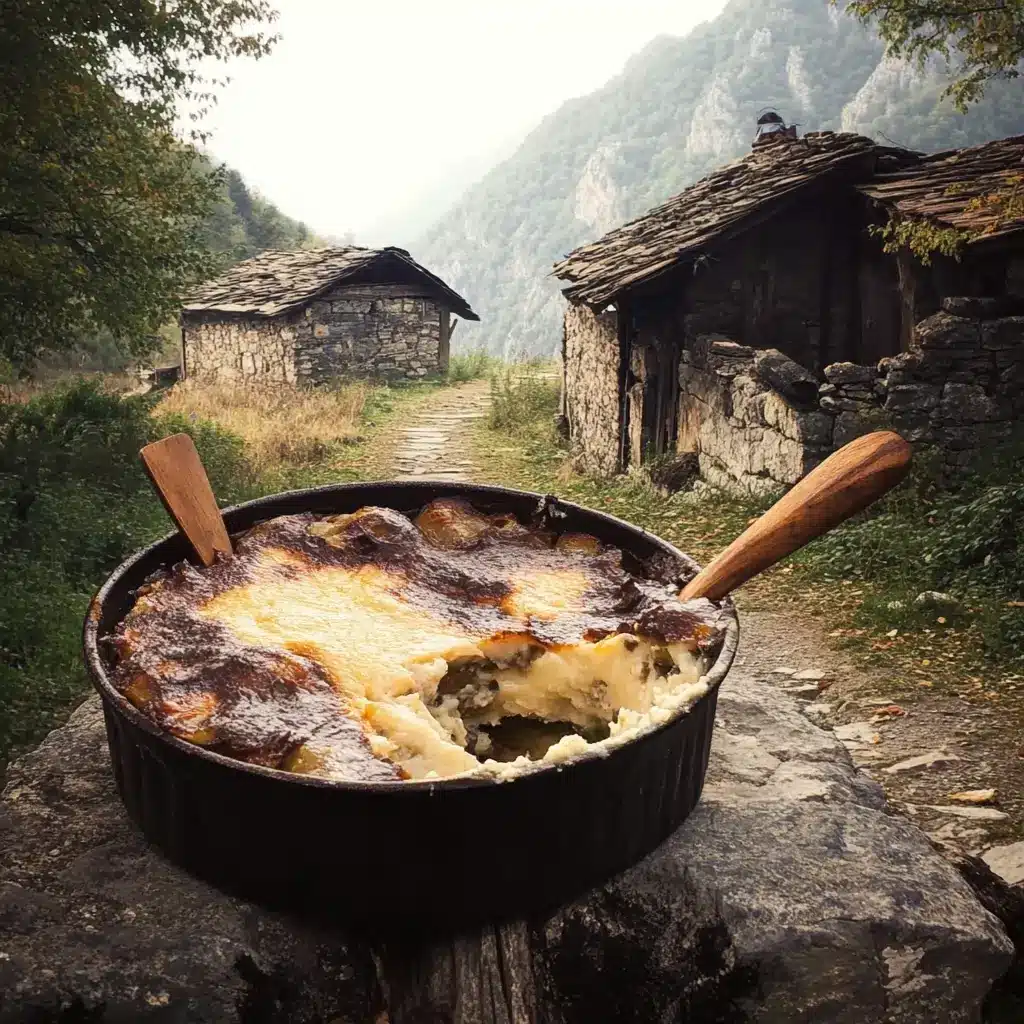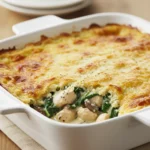The first time the aroma of Tavë Kosi filled my kitchen, it was like an olfactory passport to a sun-drenched Albanian village. I’d heard whispers of this legendary dish – a comforting, savory bake of tender lamb and rice, all enrobed in a rich, tangy yogurt custard. Skeptical but intrigued, I embarked on the culinary adventure. As it baked, the scent intensified: earthy lamb, a hint of garlic and oregano, and the unique, slightly sour tang of warm yogurt. When I finally pulled that golden-brown, bubbling casserole from the oven, my family gathered, drawn by the irresistible perfume. The first bite was a revelation. The lamb was fall-apart tender, the rice perfectly cooked and infused with the meat’s juices, and the yogurt topping? It was creamy, slightly tart, and utterly divine, like a savory, ethereal cloud. It wasn’t just a meal; it was an experience. It instantly became a family favorite, a dish requested for special occasions and cozy Sunday dinners alike. It’s more than just food; it’s a hug in a bowl, a taste of Albanian hospitality and tradition that I’m thrilled to share.
What is Tavë Kosi? A Culinary Journey to Albania
Tavë Kosi, translating literally to “soured milk casserole” or “yogurt casserole,” is widely regarded as one of Albania’s national dishes. Its origins are often traced back to the city of Elbasan in central Albania, though variations exist throughout the country and in neighboring regions with Albanian populations, like Kosovo and parts of North Macedonia. This beloved dish is a testament to the resourcefulness and rich culinary heritage of the Albanian people, transforming simple, hearty ingredients into something truly special.
At its heart, Tavë Kosi is a baked dish featuring tender, succulent lamb (or sometimes chicken) and rice, all enveloped in a thick, creamy, and slightly tangy sauce made primarily from yogurt and eggs, often with a touch of flour or a roux for stability. The magic happens in the oven, where the ingredients meld together, the lamb becomes incredibly tender, the rice absorbs the flavorful meat juices, and the yogurt topping transforms into a golden, soufflé-like custard.
The flavor profile is unique and captivating. The richness of the lamb is perfectly balanced by the tartness of the yogurt, while garlic and oregano (common herbs in Albanian cuisine) add aromatic depth. The rice provides a comforting, starchy base that soaks up all the deliciousness. It’s a dish that is simultaneously hearty and comforting, yet surprisingly light thanks to the yogurt.
Traditionally, Tavë Kosi was a dish often prepared for special occasions, celebrations, or to honor guests, reflecting the high esteem in which lamb is held in Albanian culinary culture. Today, while still a festive centerpiece, it’s also enjoyed as a deeply satisfying family meal. Its enduring popularity speaks to its deliciousness and its embodiment of Albanian home cooking – wholesome, flavorful, and made with love. Preparing Tavë Kosi is not just about following a recipe; it’s about connecting with a tradition and creating a dish that warms both body and soul.
Ingredients for Authentic Tavë Kosi
Crafting an authentic Tavë Kosi requires quality ingredients. Each component plays a vital role in building the layers of flavor and texture that make this dish so iconic.
For the Lamb & Rice Base:
- Lamb: 2-2.5 lbs (approx. 1-1.2 kg) bone-in lamb shoulder or leg, cut into 2-3 inch pieces.
- Why bone-in? The bones impart incredible depth of flavor to the cooking liquid and subsequently to the rice. Lamb shoulder or leg offers a good balance of meat and fat, ensuring tenderness and richness.
- Short-grain Rice: 1 cup (approx. 200g), such as Arborio, Calasparra, or even a good quality pudding rice.
- Why short-grain? These varieties are starchier and absorb liquid well, becoming creamy and tender without turning mushy, contributing to the dish’s comforting texture.
- Yellow Onion: 1 large, finely chopped.
- Role: Provides a sweet, aromatic foundation for the dish.
- Garlic: 4-6 cloves, minced.
- Role: Adds a pungent, savory kick that complements the lamb and yogurt beautifully.
- Unsalted Butter: 4 tablespoons (approx. 56g), divided.
- Role: Used for searing the lamb and enriching the rice and yogurt sauce.
- Olive Oil: 2 tablespoons.
- Role: Works with butter to sear the lamb at a higher smoke point.
- Lamb Broth or Water: 4 cups (approx. 950 ml), or enough to cover lamb during initial cooking.
- Role: Creates the flavorful liquid in which the lamb simmers and the rice later cooks. Homemade lamb broth is ideal, but good quality store-bought or even water will work, as the lamb itself will create a rich broth.
- Dried Oregano: 1 tablespoon.
- Role: A classic Mediterranean herb that pairs exceptionally well with lamb.
- Salt: To taste (start with 1.5 teaspoons for the lamb).
- Black Pepper: To taste (start with 1/2 teaspoon for the lamb).
For the Yogurt Custard Topping:
- Plain Full-Fat Yogurt: 4 cups (approx. 900-1000g). Greek yogurt is an excellent choice for its thickness and tang.
- Why full-fat? It provides the best flavor and creamy texture. Low-fat yogurt can result in a thinner, less satisfying topping. The tang of the yogurt is crucial to the dish’s identity.
- Eggs: 4 large, at room temperature.
- Role: They act as a binding agent, helping the yogurt topping to set into a light, airy, soufflé-like custard when baked. Room temperature eggs incorporate better.
- All-Purpose Flour: 3 tablespoons.
- Role: Helps to thicken the yogurt sauce and prevent it from splitting or becoming too watery during baking. It creates a light roux with butter.
- Unsalted Butter: 2 tablespoons (for the roux).
- Salt: ½ teaspoon, or to taste, for the yogurt mixture.
- A pinch of Nutmeg (optional): Adds a subtle warmth to the custard.
Step-by-Step Instructions: Crafting Your Tavë Kosi Masterpiece
Follow these detailed steps to create a show-stopping Tavë Kosi that will transport your taste buds to Albania.
H3: Preparing and Simmering the Lamb
- Season the Lamb: Pat the lamb pieces dry with paper towels. Season generously with salt, black pepper, and dried oregano. Rub the seasonings into the meat.
- Sear the Lamb: In a large, heavy-bottomed pot or Dutch oven, heat 2 tablespoons of olive oil and 2 tablespoons of butter over medium-high heat. Once the butter is melted and foaming, add the lamb pieces in a single layer (work in batches if necessary to avoid overcrowding). Sear on all sides until nicely browned, about 3-5 minutes per side. This develops a deep, savory crust (Maillard reaction) which is crucial for flavor. Remove the seared lamb and set aside on a plate.
- Sauté Aromatics: To the same pot, add the chopped onion. Sauté over medium heat until softened and translucent, about 5-7 minutes, scraping up any browned bits from the bottom of the pot (these are full of flavor!). Add the minced garlic and cook for another minute until fragrant, being careful not to burn it.
- Simmer the Lamb: Return the seared lamb pieces to the pot. Pour in the lamb broth or water, ensuring the lamb is mostly submerged. Bring to a simmer, then reduce the heat to low, cover the pot, and let it cook gently for 1.5 – 2 hours, or until the lamb is very tender and almost falling off the bone. Skim off any impurities that rise to the surface during the initial simmering.
- Strain and Reserve Broth: Once the lamb is tender, carefully remove the lamb pieces from the pot and set them aside. Strain the cooking broth through a fine-mesh sieve into a clean bowl. You should have at least 2 cups of rich broth; if not, top it up with a little water or more broth. Discard the solids from the sieve. Clean the pot if there’s excessive residue, or use an oven-safe baking dish for the next steps.
H3: Cooking the Rice
- Prepare Rice Base: In the same pot (or a large oven-safe baking dish – a 9×13 inch or similar sized earthenware dish is traditional), melt the remaining 2 tablespoons of butter over medium heat.
- Toast the Rice: Add the short-grain rice to the melted butter and stir for 1-2 minutes until the grains are coated and slightly translucent at the edges. This toasting step enhances the nutty flavor of the rice.
- Add Broth: Pour 2 cups of the reserved hot lamb broth over the rice. Bring to a gentle simmer. Season lightly with a pinch of salt if needed (remember the broth is already seasoned).
H3: Making the Yogurt Custard
- Make the Roux: While the rice is coming to a simmer, prepare the yogurt topping. In a separate medium saucepan, melt the 2 tablespoons of butter over medium-low heat. Whisk in the 3 tablespoons of flour and cook, whisking constantly, for 1-2 minutes to create a smooth, blonde roux. This cooks out the raw flour taste. Remove from heat and let it cool slightly.
- Temper the Eggs: In a large mixing bowl, whisk the eggs until well combined.
- Combine Yogurt and Roux: Gradually whisk a small amount of the full-fat yogurt into the slightly cooled roux until smooth. Then, add this roux-yogurt mixture to the bowl with the remaining yogurt. Whisk thoroughly until completely smooth and homogenous.
- Incorporate Eggs: Slowly drizzle the whisked eggs into the yogurt mixture, whisking constantly to prevent the eggs from scrambling. Ensure it’s fully incorporated.
- Season Custard: Season the yogurt custard with ½ teaspoon of salt (or to taste) and the optional pinch of nutmeg. Whisk again. The consistency should be like a thick pancake batter.
H3: Assembling and Baking Tavë Kosi
- Preheat Oven: Preheat your oven to 375°F (190°C).
- Arrange Lamb: If you cooked the rice in a pot, you can either transfer it to a suitable baking dish now or use the oven-safe pot. Arrange the tender lamb pieces evenly over the rice and broth mixture.
- Pour Custard: Gently and evenly pour the prepared yogurt custard mixture over the lamb and rice. Ensure it covers everything completely. The lamb pieces might poke through slightly, which is fine.
- Bake: Carefully transfer the baking dish to the preheated oven. Bake for 40-50 minutes, or until the yogurt topping is beautifully golden brown, puffed up, and set. A knife inserted into the center of the custard should come out mostly clean (a little moisture is okay, but it shouldn’t be liquid). The edges should be bubbling gently.
- Rest: Once baked, remove the Tavë Kosi from the oven and let it rest for at least 15-20 minutes before serving. This allows the custard to set further and the flavors to meld, and it also prevents you from burning your mouth on the molten interior! The topping will deflate slightly as it cools, which is normal.
Nutritional Snapshot: Understanding Your Tavë Kosi
- Servings: This recipe generously serves 6-8 people.
- Estimated Calories per Serving: Approximately 550-750 calories per serving.
Disclaimer: Nutritional information is an estimate and can vary significantly based on specific ingredient choices (e.g., fat content of lamb and yogurt), portion sizes, and any modifications made to the recipe. This is provided for general guidance only.
Time Commitment: Planning Your Tavë Kosi Adventure
Understanding the time involved will help you plan accordingly for this delightful dish.
- Preparation Time: 45 minutes (includes searing lamb, chopping vegetables, preparing yogurt sauce)
- Cooking Time: 2 hours 30 minutes to 3 hours (1.5-2 hours for simmering lamb, 40-50 minutes for baking)
- Resting Time: 15-20 minutes
- Total Time: Approximately 3 hours 30 minutes to 4 hours 5 minutes
While it requires a bit of time, much of it is passive cooking (simmering and baking), allowing you to attend to other things.
How to Serve Tavë Kosi: Presentation and Pairings
Serving Tavë Kosi is an event in itself. Its rustic charm and incredible aroma make it an inviting centerpiece.
- Serving Temperature: Tavë Kosi is best served warm, not piping hot. The resting period is crucial for both flavor development and safe eating temperature.
- Presentation:
- Bring the baking dish directly to the table for a rustic, family-style presentation.
- Spoon generous portions onto individual plates, ensuring each serving gets a good piece of lamb, some rice, and a hearty dollop of the golden custard.
- Garnish: A simple sprinkle of fresh chopped parsley or a few fresh oregano leaves can add a touch of color and freshness. A light dusting of paprika can also be visually appealing.
- Accompaniments & Side Dishes:
- Crusty Bread: Essential for soaking up any remaining delicious sauce and juices. A traditional Albanian cornbread (Bukë Misri) would be authentic, but any good quality sourdough or rustic white bread works well.
- Fresh Salad: A simple green salad with a light vinaigrette, or a traditional Albanian shepherd’s salad (Shopska salad variant with tomatoes, cucumbers, onions, peppers, and feta) provides a refreshing contrast to the richness of the Tavë Kosi.
- Pickled Vegetables (Turshi): The acidity of pickled vegetables cuts through the richness beautifully.
- Plain Yogurt: Some enjoy an extra dollop of fresh, cool yogurt on the side.
- Drink Pairings:
- Red Wine: A medium-bodied red wine, such as a Kallmet (an Albanian varietal), Merlot, or Cabernet Franc, complements the lamb well.
- White Wine: A crisp, dry white wine can also work, especially if you prefer a lighter pairing.
- Raki: For a truly traditional experience, a small glass of Albanian Raki (a fruit brandy) can be served, often as an aperitif or digestif.
- Sparkling Water with Lemon: A refreshing non-alcoholic option.
Chef’s Secrets: Additional Tips for Tavë Kosi Perfection
- Quality of Yogurt is Key: Do not skimp on the yogurt. Use a good quality, full-fat, plain yogurt, preferably Greek yogurt for its thickness and tang. This is the star of the topping and significantly impacts the final flavor and texture. Avoid sweetened or flavored yogurts.
- Don’t Rush the Lamb: The tenderness of the lamb is paramount. Ensure it’s simmered gently for long enough that it’s truly fall-apart tender before assembling the dish. This slow cooking also creates a more flavorful broth for the rice.
- Temper Your Eggs Carefully: When adding eggs to the yogurt mixture (or when adding the yogurt-roux mixture to the eggs, depending on your method), do it gradually and whisk constantly. If the yogurt or roux is too hot, or if you add the eggs too quickly, they can scramble, resulting in a grainy custard.
- Rest is Best: Allowing the Tavë Kosi to rest for at least 15-20 minutes after baking is crucial. It allows the custard to set properly, makes it easier to serve, and lets the flavors meld. It will still be plenty warm.
- Adjust Seasoning at Each Stage: Taste and adjust seasoning as you go. Season the lamb, the broth (if needed, after the lamb has cooked), and the yogurt custard. This layering of seasoning ensures a well-balanced and flavorful final dish.
Tavë Kosi FAQs: Your Questions Answered
Q1: Can I use a different meat instead of lamb?
A: Yes, while lamb is traditional and provides a distinctive flavor, chicken is a common and delicious alternative. Use bone-in, skin-on chicken pieces (thighs and drumsticks work well). The simmering time for chicken will be shorter, around 45-60 minutes, or until tender. Beef can also be used, particularly stewing cuts, but it will require a longer simmering time, similar to or even longer than lamb, to become tender.
Q2: Can I make Tavë Kosi ahead of time?
A: You can prepare components ahead. The lamb can be simmered, deboned (if desired, though traditionally served on the bone), and stored in its broth in the refrigerator for up to 2 days. The dish is best assembled and baked fresh for the optimal texture of the yogurt custard. Reheating a fully baked Tavë Kosi can sometimes make the custard a bit watery, though it will still be tasty. If reheating, do so gently in a moderate oven.
Q3: How do I store and reheat leftovers?
A: Store leftover Tavë Kosi in an airtight container in the refrigerator for up to 3-4 days. To reheat, you can use a microwave for individual portions, but for best results, reheat in an oven preheated to 325°F (160°C) until warmed through, about 15-20 minutes. Covering it with foil can help prevent the top from over-browning.
Q4: Is Tavë Kosi gluten-free?
A: As written, this recipe is not gluten-free due to the all-purpose flour used in the roux for the yogurt custard. To make it gluten-free, you can substitute the all-purpose flour with a good quality gluten-free all-purpose flour blend or cornstarch (use about half the amount if using cornstarch, and make a slurry with a little cold water/yogurt before adding). Ensure your rice and other ingredients are also certified gluten-free if catering to celiac disease.
Q5: My yogurt custard turned out a bit runny. What might have gone wrong?
A: Several factors could contribute to a runny custard:
* Not enough thickener: Perhaps not enough flour was used, or it wasn’t cooked properly into a roux.
* Low-fat yogurt: Lower fat yogurts have more water content and can lead to a runnier result.
* Not baked long enough: The custard might not have had enough time to set in the oven.
* Eggs not properly incorporated/tempered: This can affect the setting ability.
* Too much liquid in the rice base: If the rice base was overly wet, the excess moisture could have thinned the custard.
Ensure your yogurt is thick, you use enough flour, and bake until the custard is visibly set and golden.

Tavë Kosi Recipe
Ingredients
For the Lamb & Rice Base:
- Lamb: 2-2.5 lbs (approx. 1-1.2 kg) bone-in lamb shoulder or leg, cut into 2-3 inch pieces.
- Why bone-in? The bones impart incredible depth of flavor to the cooking liquid and subsequently to the rice. Lamb shoulder or leg offers a good balance of meat and fat, ensuring tenderness and richness.
- Short-grain Rice: 1 cup (approx. 200g), such as Arborio, Calasparra, or even a good quality pudding rice.
- Why short-grain? These varieties are starchier and absorb liquid well, becoming creamy and tender without turning mushy, contributing to the dish’s comforting texture.
- Yellow Onion: 1 large, finely chopped.
- Role: Provides a sweet, aromatic foundation for the dish.
- Garlic: 4-6 cloves, minced.
- Role: Adds a pungent, savory kick that complements the lamb and yogurt beautifully.
- Unsalted Butter: 4 tablespoons (approx. 56g), divided.
- Role: Used for searing the lamb and enriching the rice and yogurt sauce.
- Olive Oil: 2 tablespoons.
- Role: Works with butter to sear the lamb at a higher smoke point.
- Lamb Broth or Water: 4 cups (approx. 950 ml), or enough to cover lamb during initial cooking.
- Role: Creates the flavorful liquid in which the lamb simmers and the rice later cooks. Homemade lamb broth is ideal, but good quality store-bought or even water will work, as the lamb itself will create a rich broth.
- Dried Oregano: 1 tablespoon.
- Role: A classic Mediterranean herb that pairs exceptionally well with lamb.
- Salt: To taste (start with 1.5 teaspoons for the lamb).
- Black Pepper: To taste (start with 1/2 teaspoon for the lamb).
For the Yogurt Custard Topping:
- Plain Full-Fat Yogurt: 4 cups (approx. 900-1000g). Greek yogurt is an excellent choice for its thickness and tang.
- Why full-fat? It provides the best flavor and creamy texture. Low-fat yogurt can result in a thinner, less satisfying topping. The tang of the yogurt is crucial to the dish’s identity.
- Eggs: 4 large, at room temperature.
- Role: They act as a binding agent, helping the yogurt topping to set into a light, airy, soufflé-like custard when baked. Room temperature eggs incorporate better.
- All-Purpose Flour: 3 tablespoons.
- Role: Helps to thicken the yogurt sauce and prevent it from splitting or becoming too watery during baking. It creates a light roux with butter.
- Unsalted Butter: 2 tablespoons (for the roux).
- Salt: ½ teaspoon, or to taste, for the yogurt mixture.
- A pinch of Nutmeg (optional): Adds a subtle warmth to the custard.
Instructions
H3: Preparing and Simmering the Lamb
- Season the Lamb: Pat the lamb pieces dry with paper towels. Season generously with salt, black pepper, and dried oregano. Rub the seasonings into the meat.
- Sear the Lamb: In a large, heavy-bottomed pot or Dutch oven, heat 2 tablespoons of olive oil and 2 tablespoons of butter over medium-high heat. Once the butter is melted and foaming, add the lamb pieces in a single layer (work in batches if necessary to avoid overcrowding). Sear on all sides until nicely browned, about 3-5 minutes per side. This develops a deep, savory crust (Maillard reaction) which is crucial for flavor. Remove the seared lamb and set aside on a plate.
- Sauté Aromatics: To the same pot, add the chopped onion. Sauté over medium heat until softened and translucent, about 5-7 minutes, scraping up any browned bits from the bottom of the pot (these are full of flavor!). Add the minced garlic and cook for another minute until fragrant, being careful not to burn it.
- Simmer the Lamb: Return the seared lamb pieces to the pot. Pour in the lamb broth or water, ensuring the lamb is mostly submerged. Bring to a simmer, then reduce the heat to low, cover the pot, and let it cook gently for 1.5 – 2 hours, or until the lamb is very tender and almost falling off the bone. Skim off any impurities that rise to the surface during the initial simmering.
- Strain and Reserve Broth: Once the lamb is tender, carefully remove the lamb pieces from the pot and set them aside. Strain the cooking broth through a fine-mesh sieve into a clean bowl. You should have at least 2 cups of rich broth; if not, top it up with a little water or more broth. Discard the solids from the sieve. Clean the pot if there’s excessive residue, or use an oven-safe baking dish for the next steps.
H3: Cooking the Rice
- Prepare Rice Base: In the same pot (or a large oven-safe baking dish – a 9×13 inch or similar sized earthenware dish is traditional), melt the remaining 2 tablespoons of butter over medium heat.
- Toast the Rice: Add the short-grain rice to the melted butter and stir for 1-2 minutes until the grains are coated and slightly translucent at the edges. This toasting step enhances the nutty flavor of the rice.
- Add Broth: Pour 2 cups of the reserved hot lamb broth over the rice. Bring to a gentle simmer. Season lightly with a pinch of salt if needed (remember the broth is already seasoned).
H3: Making the Yogurt Custard
- Make the Roux: While the rice is coming to a simmer, prepare the yogurt topping. In a separate medium saucepan, melt the 2 tablespoons of butter over medium-low heat. Whisk in the 3 tablespoons of flour and cook, whisking constantly, for 1-2 minutes to create a smooth, blonde roux. This cooks out the raw flour taste. Remove from heat and let it cool slightly.
- Temper the Eggs: In a large mixing bowl, whisk the eggs until well combined.
- Combine Yogurt and Roux: Gradually whisk a small amount of the full-fat yogurt into the slightly cooled roux until smooth. Then, add this roux-yogurt mixture to the bowl with the remaining yogurt. Whisk thoroughly until completely smooth and homogenous.
- Incorporate Eggs: Slowly drizzle the whisked eggs into the yogurt mixture, whisking constantly to prevent the eggs from scrambling. Ensure it’s fully incorporated.
- Season Custard: Season the yogurt custard with ½ teaspoon of salt (or to taste) and the optional pinch of nutmeg. Whisk again. The consistency should be like a thick pancake batter.
H3: Assembling and Baking Tavë Kosi
- Preheat Oven: Preheat your oven to 375°F (190°C).
- Arrange Lamb: If you cooked the rice in a pot, you can either transfer it to a suitable baking dish now or use the oven-safe pot. Arrange the tender lamb pieces evenly over the rice and broth mixture.
- Pour Custard: Gently and evenly pour the prepared yogurt custard mixture over the lamb and rice. Ensure it covers everything completely. The lamb pieces might poke through slightly, which is fine.
- Bake: Carefully transfer the baking dish to the preheated oven. Bake for 40-50 minutes, or until the yogurt topping is beautifully golden brown, puffed up, and set. A knife inserted into the center of the custard should come out mostly clean (a little moisture is okay, but it shouldn’t be liquid). The edges should be bubbling gently.
- Rest: Once baked, remove the Tavë Kosi from the oven and let it rest for at least 15-20 minutes before serving. This allows the custard to set further and the flavors to meld, and it also prevents you from burning your mouth on the molten interior! The topping will deflate slightly as it cools, which is normal.
Nutrition
- Serving Size: One Normal Portion
- Calories: 550-750






